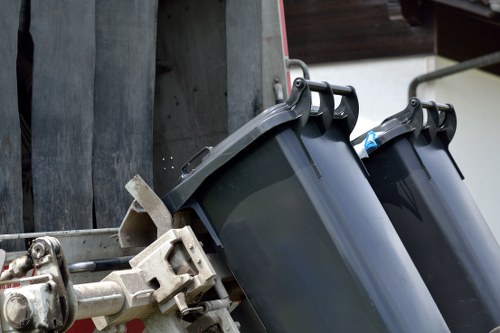Builders Waste Clearance in Sudbury

Effective builders waste clearance is essential for maintaining a clean and safe environment during and after construction projects in Sudbury. Whether you're undertaking a small renovation or a large-scale building project, proper waste management ensures compliance with local regulations and promotes sustainability.
In Sudbury, the demand for reliable waste clearance services has been on the rise, driven by the growing construction industry and increased environmental awareness. Builders and contractors need efficient solutions to handle various types of waste, from typical construction debris to hazardous materials.
Choosing the right waste clearance service can significantly impact the project's timeline, budget, and overall success. This article explores the key aspects of builders waste clearance in Sudbury, providing insights into best practices, legal requirements, and the benefits of professional services.
Understanding Builders Waste Clearance

Builders waste clearance involves the removal and disposal of waste generated from construction activities. This includes materials like concrete, bricks, timber, metals, drywall, and other construction-related debris. Proper clearance not only keeps the site organized but also minimizes environmental impact.
In Sudbury, waste clearance must adhere to specific local regulations aimed at reducing landfill usage and promoting recycling. Builders are required to segregate waste, ensuring that recyclable materials are appropriately processed, and hazardous waste is safely disposed of.
Effective waste management contributes to a project's sustainability, reducing the carbon footprint and supporting the local economy through recycling and reuse initiatives.
Types of Builders Waste

The waste generated in construction projects can be categorized into several types:
- Organic Waste: Includes materials like wood, paper, and other biodegradable substances.
- Inorganic Waste: Comprises non-biodegradable materials such as metals, plastics, and glass.
- Hazardous Waste: Consists of materials that are dangerous or potentially harmful, including asbestos, lead-based paints, and certain chemicals.
- Recyclable Waste: Items that can be processed and reused, such as concrete, metals, and certain plastics.
Identifying and categorizing waste is the first step towards effective waste clearance and compliance with environmental standards.
Proper segregation of waste ensures that recyclable and hazardous materials are handled appropriately, reducing the overall environmental impact.
Legal Requirements in Sudbury

Builders waste clearance in Sudbury is governed by local and provincial regulations designed to protect the environment and public health. Compliance with these laws is mandatory and can prevent hefty fines and project delays.
Key legal requirements include:
- Waste Segregation: Separating waste into categories such as recyclable, non-recyclable, and hazardous.
- Permits and Licensing: Obtaining the necessary permits for waste transportation and disposal.
- Recycling Targets: Meeting specific recycling quotas set by local authorities.
- Safe Disposal Practices: Ensuring that hazardous waste is disposed of in accordance with safety standards.
Adhering to these requirements not only ensures legal compliance but also fosters a culture of responsibility and sustainability within the construction industry.
Benefits of Professional Waste Clearance Services

Engaging professional waste clearance services offers numerous advantages for builders in Sudbury:
- Efficiency: Professional services streamline the waste removal process, saving time and resources.
- Compliance: Experts are well-versed in local regulations, ensuring all legal requirements are met.
- Environmental Responsibility: Professionals prioritize recycling and proper disposal, minimizing environmental impact.
- Cost-Effectiveness: Efficient waste management can reduce overall project costs by preventing fines and optimizing resource usage.
Moreover, professional services often provide tailored solutions to fit the specific needs of a project, enhancing overall effectiveness.
Investing in quality waste clearance services is a strategic decision that pays dividends in project success and environmental stewardship.
Best Practices for Builders Waste Clearance
Implementing best practices in waste clearance can significantly enhance the efficiency and sustainability of construction projects in Sudbury.
Here are some recommended practices:
- Plan Ahead: Integrate waste management into the project planning phase to anticipate and address waste generation.
- Educate the Team: Train workers on proper waste segregation and handling to ensure compliance and efficiency.
- Use Recyclable Materials: Opt for materials that can be easily recycled to reduce overall waste.
- Regular Monitoring: Continuously assess waste generation and clearance processes to identify improvements.
- Partner with Reputable Services: Collaborate with experienced waste clearance providers who adhere to best practices and legal standards.
Adopting these practices fosters a culture of sustainability and responsibility, benefiting both the environment and the project's bottom line.
Proactive waste management not only ensures regulatory compliance but also enhances the reputation of builders as environmentally conscious professionals.
Cost Factors in Waste Clearance
Understanding the cost factors involved in builders waste clearance is crucial for budgeting and financial planning.
Key cost elements include:
- Volume and Weight of Waste: Larger volumes and heavier materials incur higher disposal costs.
- Type of Waste: Hazardous and non-recyclable waste is more expensive to handle and dispose of compared to recyclable materials.
- Transportation: Costs vary based on the distance to disposal sites and the number of trips required.
- Permitting and Licensing: Obtaining necessary permits can add to the overall costs.
- Service Frequency: Regular clearance services may offer discounted rates compared to one-time removals.
By understanding these factors, builders can make informed decisions to optimize costs without compromising on quality and compliance.
Budgeting wisely for waste clearance ensures that financial resources are allocated efficiently, contributing to the smooth progression of construction projects.
Choosing the Right Waste Clearance Partner
Selecting a reliable waste clearance partner in Sudbury is paramount to the success of your construction project. Here are some criteria to consider:
- Experience and Expertise: Look for companies with a proven track record in handling various types of builders waste.
- Compliance: Ensure the service provider adheres to local regulations and environmental standards.
- Comprehensive Services: Choose a provider that offers a full range of services, from waste collection to recycling and disposal.
- Customer Support: Responsive and supportive customer service can make the clearance process smoother and more efficient.
- Competitive Pricing: Obtain quotes from multiple providers to find a balance between cost and quality.
Taking the time to evaluate potential partners ensures that you select a service that aligns with your project's needs and values.
Partnering with the right waste clearance company can enhance project efficiency, reduce costs, and support environmental sustainability.
The Environmental Impact of Builders Waste Clearance
Builders waste clearance plays a significant role in minimizing the environmental footprint of construction activities in Sudbury.
By implementing effective waste management strategies, builders can:
- Reduce Landfill Usage: Proper segregation and recycling decrease the volume of waste sent to landfills.
- Conserve Resources: Recycling materials like metal and wood conserves natural resources and reduces the need for new raw materials.
- Lower Greenhouse Gas Emissions: Efficient waste processing and transportation can reduce emissions associated with construction projects.
- Protect Ecosystems: Safe disposal of hazardous waste prevents contamination of soil and water bodies, safeguarding local ecosystems.
Embracing sustainable waste clearance practices contributes to the overall environmental health of Sudbury and aligns with global sustainability goals.
Sustainability in construction is achievable through conscientious waste management, promoting a greener and more resilient community.
Innovations in Builders Waste Clearance
The field of builders waste clearance is evolving, with new technologies and practices enhancing efficiency and sustainability.
Recent innovations include:
- Automated Sorting Systems: Advanced machinery that separates waste materials quickly and accurately, improving recycling rates.
- IoT-Based Waste Management: Smart sensors that monitor waste levels in real-time, optimizing collection schedules and reducing unnecessary trips.
- Eco-Friendly Disposal Methods: Techniques like waste-to-energy conversion that reduce reliance on traditional landfills.
- Digital Tracking: Platforms that allow builders to track waste disposal and recycling metrics, ensuring transparency and accountability.
Adopting these innovations can lead to more efficient and environmentally friendly waste clearance processes, benefitting both builders and the community.
Staying updated with the latest advancements ensures that builders can implement the most effective and sustainable waste management strategies.
Future Trends in Waste Clearance
The future of builders waste clearance in Sudbury is likely to be shaped by increasing environmental regulations, technological advancements, and a growing emphasis on sustainability.
Anticipated trends include:
- Increased Recycling Rates: Enhanced recycling technologies and stricter regulations will push for higher reuse of construction materials.
- Zero-Waste Construction: Aiming for projects that generate no waste by optimizing material use and recycling all by-products.
- Green Certifications: Builders may seek certifications that recognize sustainable waste management practices.
- Collaborative Platforms: Digital tools that facilitate better coordination between builders, waste clearance services, and recycling facilities.
Embracing these trends will help builders stay ahead of regulatory changes and meet the growing demand for sustainable construction practices.
The path forward for builders waste clearance involves integrating innovative solutions and adhering to evolving best practices to foster a sustainable construction industry.
Conclusion
Builders waste clearance in Sudbury is a critical component of successful and sustainable construction projects. By understanding the types of waste, adhering to legal requirements, and partnering with professional waste clearance services, builders can efficiently manage waste, minimize environmental impact, and ensure project compliance.
Implementing best practices and staying abreast of industry innovations further enhances waste management efforts, contributing to a greener and more organized construction landscape in Sudbury.
Contact us today to learn more about our comprehensive waste clearance services and how we can support your next construction project.